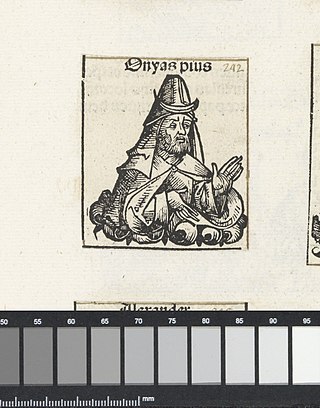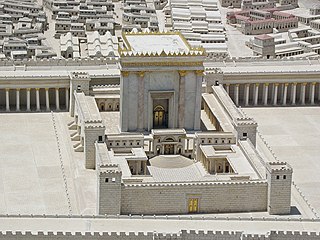Related Research Articles
This article concerns the period 169 BC – 160 BC.

The Maccabees, also spelled Machabees, were a group of Jewish rebel warriors who took control of Judea, which at the time was part of the Seleucid Empire. Its leaders, the Hasmoneans, founded the Hasmonean dynasty, which ruled from 167 BCE to 37 BCE, being a fully independent kingdom from 104 to 63 BCE. They reasserted the Jewish religion, expanded the boundaries of Judea by conquest, and reduced the influence of Hellenism and Hellenistic Judaism.

The Hasmonean dynasty was a ruling dynasty of Judea and surrounding regions during the Hellenistic times of the Second Temple period, from c. 140 BCE to 37 BCE. Between c. 140 and c. 116 BCE the dynasty ruled Judea semi-autonomously in the Seleucid Empire, and from roughly 110 BCE, with the empire disintegrating, Judea gained further autonomy and expanded into the neighboring regions of Perea, Samaria, Idumea, Galilee, and Iturea. The Hasmonean rulers took the Greek title basileus ("king") as the kingdom became a regional power for several decades. Forces of the Roman Republic intervened in the Hasmonean Civil War in 63 BCE and made it into a client state, marking the decline of Hasmonean dynasty; Herod the Great displaced the last reigning Hasmonean client-ruler in 37 BCE.

Judas Maccabaeus or Maccabeus, also known as Judah Maccabee, was a Jewish priest (kohen) and a son of the priest Mattathias. He led the Maccabean Revolt against the Seleucid Empire.

John Hyrcanus was a Hasmonean (Maccabean) leader and Jewish High Priest of Israel of the 2nd century BCE. In rabbinic literature he is often referred to as Yoḥanan Cohen Gadol, "John the High Priest".

The Battle of Beth Zechariah took place around May 162 BC during the Maccabean revolt fought between Jewish rebels under the leadership of Judas Maccabeus against an army of the Seleucid Empire, the Greek successor state (diadochi) to the Macedonian conquests that controlled Syria and Babylonia. The battle was fought at Beth Zechariah and was a Seleucid victory, with the rebels driven from the field in retreat. Judas's brother Eleazar Avaran died in combat with a war elephant. The defeat allowed the Seleucids to continue their campaign and besiege the Jewish holy city of Jerusalem.

Jonathan Apphus was one of the sons of Mattathias and the leader of the Hasmonean dynasty of Judea from 161 to 143 BCE.
Alcimus, also called Jakeimos, Jacimus, or Joachim (Ἰάκειμος), was High Priest of Israel for three years from 162–159 BCE. He was a moderate Hellenizer who favored the ruling government of the Seleucid Empire and opposed the Maccabean Revolt which was in progress at the time.
The Battle of Adasa was fought during the Maccabean revolt on the 13th of the month Adar, 161 BC at Adasa, near Beth-horon. It was a battle between the rebel Maccabees of Judas Maccabeus and the Seleucid Empire, whose army was led by Nicanor. The Maccabees won the battle after killing Nicanor early in the fighting. The battle came after a period of political maneuvering over several months where the peace deal established a year earlier by Lysias was tested by the new High Priest Alcimus, the new military governor Nicanor, and the Maccabee leader Judas Maccabeus.

The Acra, with the meaning of "stronghold", was a place in Jerusalem thought to have had a fortified compound built by Antiochus Epiphanes, ruler of the Seleucid Empire, following his sack of the city in 168 BCE. The name Acra was also used at a later time for a city quarter probably associated with the by-then destroyed fortress, known in his time to Josephus as both Acra and "the lower city". The fortress played a significant role in the events surrounding the Maccabean Revolt, which resulted in the formation of the Hasmonean Kingdom. The "upper city" was captured by Judas Maccabeus, with the Seleucid garrison taking refuge in the "Acra" below, and the task of destroying this last enemy stronghold inside Jerusalem fell to Simon Maccabeus surnamed Thassi. Knowledge about the Acra is based almost exclusively on the writings of Josephus, which are of a later date, and on the First and Second Books of Maccabees, which were written not long after the described events.
Jason was the High Priest of Israel from around 175 BCE to 171 BCE during the Second Temple period of Judaism. He was of the Oniad family and was brother to Onias III, his predecessor as High Priest. Josephus records that his name was originally Jesus or Joshua before he changed it.

Onias III, son of Simon II, was Jewish High Priest during the Second Temple period. He is described in scriptures as a pious man who opposed the Hellenization of Judea. He was succeeded by his brother Jason in 175 BCE.
The Land of Onias is the name given in Hellenistic Egyptian, Jewish, and Roman sources to an area in ancient Egypt's Nile Delta where a large number of Jews settled. The Land of Onias, which included the city of Leontopolis, was located in the Heliopolite Nome.
Ananias the son of Onias was the son of the Jewish high priest, Onias IV, who founded a Jewish Temple at Leontopolis in Egypt during the persecutions of Antiochus IV.
The Roman–Jewish Treaty was an agreement made between Judas Maccabeus and the Roman Republic according to the book 1 Maccabees and Josephus's Jewish Antiquities. It took place around 161 BCE and was the first recorded contract between Judea and Ancient Rome. The Romans apparently extended an offer of aid to the Judean rebel side of the Maccabean Revolt. It does not appear the treaty ever resulted in direct action by the Romans in support of the Hasmoneans, but it may have deterred the Seleucid Empire, the regional power in the era, from taking more extreme measures against Judea.

The Maccabean Revolt was a Jewish rebellion led by the Maccabees against the Seleucid Empire and against Hellenistic influence on Jewish life. The main phase of the revolt lasted from 167 to 160 BCE and ended with the Seleucids in control of Judea, but conflict between the Maccabees, Hellenized Jews, and the Seleucids continued until 134 BCE, with the Maccabees eventually attaining independence.

Simon II was a High Priest of Israel during the Second Temple period. He was the son of Onias II, and probably was succeeded by Onias III. There are two main sources that discuss Simon II: the Book of Sirach and possibly 3 Maccabees. Based on the Book of Sirach, Simon II was active at some point in the 190s BCE. If the reference to a High Priest Simon in 3 Maccabees is to the same person, then he was also active as High Priest in the 210s BCE as well. John J. Collins estimates his reign as 219–196 BCE for example, while Elias Bickerman suggests only that he served c. 190 BCE. He was possibly the same person as Simon the Just, although the historian Josephus thought this referred to Simon I instead.
The book 2 Maccabees contains 15 chapters. It is a deuterocanonical book originally written in Greek that is part of the Catholic, Eastern Orthodox, and Oriental Orthodox Christian biblical canons. It is still considered an important source on the Maccabean Revolt by Jews, Protestants, and secular historians of the period who do not necessarily hold the book as part of a scriptural canon. The chapters chronicle events in Judea from around 178–161 BCE during the Second Temple Period. Judea was at the time ruled by the Seleucid Empire, one of the Greek successor states that resulted from the conquests of Alexander the Great. 2 Maccabees was written by an unknown Egyptian Jew. The account is distinct from the book 1 Maccabees, which was written by someone in the Hasmonean kingdom that was formed after the success of the revolt. In general, 2 Maccabees has a more directly religious perspective than 1 Maccabees, frequently directly crediting prayers, miraculous interventions, and divine will for events.
Hellenistic Palestine is the term for historic Palestine during the Hellenistic period, when Achaemenid Syria was conquered by Alexander the Great in 333 BCE and subsumed into his growing Macedonian empire. After his death in 323 BCE, Alexander's empire was divided among his generals, the Diadochi, marking the beginning of Macedonian rule over various territories, including Coele-Syria. The region came under Ptolemaic rule beginning when Ptolemy I Soter took control of Egypt in 322 BCE and subsequently Yehud Medinata in 320 BCE due to its strategic significance. This period saw numerous conflicts as former generals vied for control, leading to ongoing power struggles and territorial exchanges.

The Second Temple period in Jewish history began with the end of the Babylonian captivity and the Persian conquest of the Babylonian Empire in 539 BCE. A new temple to replace the destroyed Solomon's Temple was built in Jerusalem by the returnees, and the Second Temple was finished around 516 BCE. Second Temple Judaism was centered around the religious leadership of the Second Temple, and lasted for six centuries. The Persians were largely tolerant of Judaism. Persian rule lasted for two centuries, but came to an end with the conquests of Macedonia under Alexander the Great in 332 BCE. Judea and the Eastern Mediterranean region came under Greek influence during the resulting Hellenistic period; Hellenistic Judaism blended both Greek and Jewish traditions. Judea was ruled in this period first by the Ptolemaic Kingdom and then by the Seleucid Empire, Greek states formed after the breakup of Alexander's Macedonian empire. The Maccabean Revolt of 167–142 BCE was initially a fight for Judean autonomy against a suppression of traditional Judaism by Seleucid King Antiochus IV, and later sought outright independence from Greek rule. The revolt's success brought about the formation of an independent Hasmonean kingdom of Judea, named for the family which had led the Jewish resistance.
References
- ↑ Hengel, Martin (1974) [1973]. Judaism and Hellenism : Studies in Their Encounter in Palestine During the Early Hellenistic Period (1st English ed.). London: SCM Press. p. 277. ISBN 0334007887.
- 1 2 3 4 5 Skolnik, Fred, ed. (2007). "Onias". Encyclopaedia Judaica . Vol. 15 (Second ed.). Macmillan Reference USA.
- ↑ Schwartz, Daniel R. (2008). 2 Maccabees. Berlin, Germany: Walter de Gruyter. p. 12–14. ISBN 978-3-11-019118-9.
- 1 2
 Gottheil, Richard; Krauss, Samuel (1901–1906). "Onias (Ονίας)". In Singer, Isidore; et al. (eds.). The Jewish Encyclopedia . New York: Funk & Wagnalls.
Gottheil, Richard; Krauss, Samuel (1901–1906). "Onias (Ονίας)". In Singer, Isidore; et al. (eds.). The Jewish Encyclopedia . New York: Funk & Wagnalls. - ↑ Tcherikover, Victor (1959). Hellenistic Civilization and the Jews. Translated by Applebaum, S. Philadelphia: The Jewish Publication Society of America. p. 138, 156, 172-174, 276, 389.
- ↑ Antiquities xi. 8, § 6; see Paul Meyer in "Philologus," 1897, lvi. 193
- ↑ Antiquities xiv. 8, § 1; "B. J." i. 9, § 4)
- ↑ Antiquities xiii. 10, § 4
- ↑ Josephus, "Contra Apion" ii. 5
![]() This article incorporates text from a publication now in the public domain : Singer, Isidore; et al., eds. (1901–1906). "Oniasc (Ονίας)". The Jewish Encyclopedia . New York: Funk & Wagnalls.
This article incorporates text from a publication now in the public domain : Singer, Isidore; et al., eds. (1901–1906). "Oniasc (Ονίας)". The Jewish Encyclopedia . New York: Funk & Wagnalls.